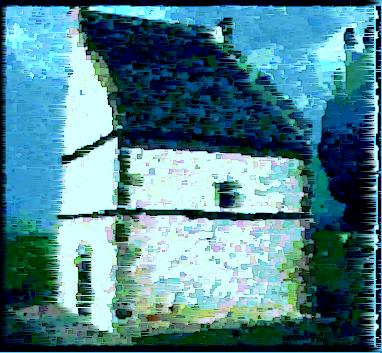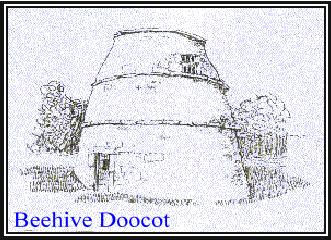|
SCOTTISH DOOCOTS
JK Gillon Line drawings by Ian Temple. 
 Dovecotes (doocots in Scotland) form prominent features in the rural landscape of many parts of Scotland. A large number have survived for centuries because of their substantial construction, and their architecture is generally a perfect expression of local craftsmanship. They have an appeal to anyone with an eye for architectural form and with their robust solid stone walls are strongly representative of national architectural tradition.
The earliest forms of dovecotes were those converted from natural caves or cut into rock, 'doo caves'. The Romans kept pigeons in a columbarium or peristeron and are recorded as being 'mad with the love of pigeons; building towers for them on the tops of their roofs'. The earliest in Britain that still exists is dated 1126 and within the Norman keep of Rochester Castle. There seems to be competition for the oldest freestanding dovecote between two early 14th century examples at Garway, Herefordshire and Hurley, Berkshire. The earliest surviving Scottish doocots date from the 16th century with possibly the oldest dated 1576, being at Mertoun House, St Boswells
Prior to the 18th century, doocots were a standard feature of Scottish landed estates. They are particularly numerous in Fife and the Lothians because estates in these areas were relatively small and consisted of mainly rich arable land producing fine agricultural crops which provided an excellent source of food for the pigeons. Doocots were also the legal right of abbeys, castles and monasteries.
Pigeons provided a valuable source of year round fresh meat and eggs, adding variety to meals in the winter months. Their droppings, which built up in the doocots, made an excellent fertiliser, and were used in the production of gunpowder and in the processes of leather tanning and cloth dyeing. There was also a prevalent belief that pigeons had medicinal properties and they were used in various forms as a cure-all for everything from the plague to baldness.
Doocots were, therefore, the valuable property of powerful landowners and there have been laws concerning them since 1424, when an Act relating to destroyers of dow-houses was passed. In 1503, under James IV, an Act directed all lairds and lords to layout deer parks, orchards, stanks for fish, cunningaries (rabbit warrens), and to erect 'dowcots' as a benefit to the community. However, pigeons could have a significant effect on surrounding crops, and by 1617 another statute was necessary on account of 'the frequent building of doucottis by all manner of persounes in all the parts' of the realm. This restricted the privilege of building doocots to owners of land which produced ten chalders or 160 bolls (1.25 cwt) of grain within 2 miles of the site of the doocot in order to attempt to ensure that the pigeons fed on the landowners' crops rather than their neighbours.
Early surviving Scottish doocots are of two main types. The first purpose built doocots, dating from the 16th century are beehive shaped, circular in section and tapering towards the top with a flat domed roof. They are constructed of rubble stone, with thicker walls in the earlier structures and little ornamentation. The other early style, which superseded the beehive design in the late 16th century, is the rectangular lectern type, which appears to be peculiar to Scotland. These have a distinctive sloping mono-pitched roof often with crow-stepped gables that provided a perch for the pigeons, and are normally divided into separate chambers. The roofs usually face south to give the birds a sunny surface to rest on, while sheltering them from northerly winds. The more sophisticated construction of the lectern type doocots allowed for greater ornamentation that became more elaborate as time went on.

Doocots continued to be built well into the 18th century and later examples have a variety of forms; cylindrical, pentagonal, hexagonal and octagonal, in all sorts of styles ranging from baronial to classical. From the mid-18th century, they were frequently constructed as ornamental features of the policies of country houses, representing a form of architectural expression and acting as eyecatchers within a designed landscape. Many of these are two-storey sometimes with other uses incorporated on the ground floor and the pigeon quarters on the upper floor. The doocot at Huntington House forms the upper floor of a small summerhouse, and, with its pilasters and pediment crowned with vases, it is perhaps one of the most elaborate.
Practically all Scottish doocots are constructed of local stone and the number of internal nesting boxes ranges from around 500 in the smaller doocots, up to well over 2000 in the largest. Access for the pigeons is normally by louvered vents in the beehive doocots and small arched openings in the lectern type. Nesting boxes were reached, for the collection of eggs and birds, by a revolving ladder called a potence. Doocots are normally provided with projecting string-courses around the outside to prevent rats getting into the structure and destroying the eggs.
The need for doocots gradually died out at the start of the 19th century as their function in providing an extra source of fresh food in wintertime became obsolete with the introduction of new farming methods that allowed for the feeding of cattle in the winter. The pigeon's habit of indiscriminate feeding was also seen as a source of social injustice (one of the minor causes of the French Revolution is said to have been the destruction of peasants' crops by pigeons owned by the French aristocracy). It is recorded that there were no fewer than 360 doocots in Fife during the 18th century, and it is little wonder that farmers began to complain. Doocots dating from the 19th century are normally associated with larger planned farm steadings where they were often included as ornamental features above the arched entrances to the farm courtyards.
It is unfortunate that so many doocots have disappeared over the years. However, they are also great survivors. It is frequently found that the doocot is the only remaining residual reminder of a great estate the rest of which has long before been wiped out by change. This is possibly due to fact that they were often converted to other uses during the 19th century. Another possible reason for their survival may be associated with the old superstition that the demolition of a doocot would result in a death within the year in the family of the person responsible for its removal. |



